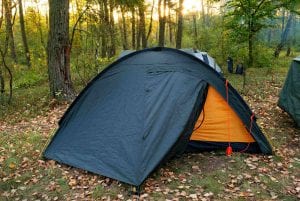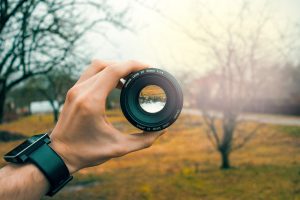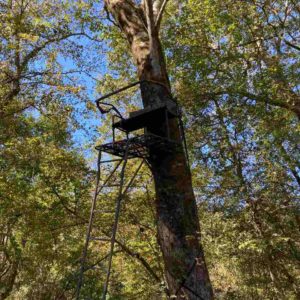Compact binoculars are smaller, lighter and more convenient than full or mid-size binoculars. They are great for backpacking and hiking, when you don’t want to be weighed down by heavier binoculars but still want to get as much as you can out of the view.
Personally, I take my compact binoculars everywhere I go. They are small enough that I can just leave them in my backpack all the time and still powerful enough to spot birds or wildlife from a long distance.
Nikon Prostaff 7S 10×30 Review – Best Compact Binoculars

Specs
The Nikon Prostaff is 10×30 inches and weighs only 14.6 oz. It has a near focus limit of about 13 feet with a bak 4 prism.
The Verdict
These lightweight binoculars are a great choice for people that want a set dynamic enough to use for just about any activity, without carrying around the bulk of a full size set. Despite the size and price, these binoculars are surprisingly sturdy (so don’t have a meltdown if they get dropped). What else is great about this model is that succeeds in delivering crisp, true to life color, which many binoculars struggle with.
In Summary…
These binoculars are small enough to take anywhere, but still, give you enough length to comfortably hold (and being waterproof is a huge bonus). They also deliver a superior picture and focus, without distorting the color in your view.
Steiner Predator 10×26 Review

Specs
The Steiner Predator binoculars are a 10×26 model and weigh about a pound. The dimensions are 7×4.25×2.5”.
The Verdict
These binoculars are great because they give a lot better light transmission, especially around the beginning and end of the day, when you need the sharpest view for spotting wildlife. While they may not be ideal for people looking for scenery or doing some birdwatching, due to the color delivery, this same characteristic makes it even better for hunters (since it enhances your ability to spot animals moving around in thick foliage).
In Summary…
If you want a pair of binoculars that will make finding your target easier, this model delivers the contrast and sharp views you need. Even better, it won’t be a hassle to carry them around with your other gear.
If you’d like more recommendations for the best compact hunting binoculars, check out this article here >>
Wingspan Optics Spectator 8×32 Review – Best Compact Binoculars for Birding

Specs
These Wingspan binoculars use a Bak 4 prism, with 8x power and 32mm lenses. They weigh 15.2 ounces and are tripod compatible.
The Verdict
These are a high-quality set of binoculars that won’t stretch your budget. They’re super easy to use and focus, not to mention to carry around thanks to their light weight. The focus and clarity are impressive, especially if you’re a bird watcher.
The other really great thing is that you get a clear picture at a wide range of distances, where other binoculars may struggle at certain depths. The bonus is that they come with a convenient carrying case and ergonomic neck strap.
In Summary…
Every level of bird watcher can enjoy these binoculars, thanks to the quality views and ease of use they offer. You can take these around for hours comfortably, whether you’re mostly holding them or carrying them around on the neck strap.
Bushnell 10×25 Legend Review- Best Lightweight Binoculars

Specs
This set of binoculars weighs only 8.2 ounces and is a 10×25 HD model. It’s waterproof and fog proof with twist up eye caps.
The Verdict
These are some of the lightest compact binoculars out there, which makes them perfect for long use and outdoor activities where you really don’t want extra weight in your pack. Don’t let the minimal weight fool you, these binoculars still deliver HD clarity. If you want to make sure you get a pair of binoculars that you can comfortably carry around for years, these make the grade, and then some.
In Summary…
As a person that likes to be outdoors in any weather, I highly recommend these compact binoculars. Not only because they’re high quality, without the price tag to match, but the anti fog feature makes a huge difference.
Celestron Nature DX 8×32 Review – Best Compact Binoculars Under 100

Specs
This pair is a compact, 8×32 set that includes a close range focus of about 6 ½ feet. It also includes Bak4 prisms and 17mm eye relief for glasses.
The Verdict
These binoculars are a solid addition to your outdoor activities, and they’re certainly durable enough to take some outdoor level wear and use. You’ll probably notice the super affordable price tag first, but make no mistake, you still get top quality light management coupled with crystal clear focus.
While there’s no color distortion, it does give you vibrant, undimmed color at any time of day. That said, astronomy fans get a bonus with this pair, as you can use them for night sky viewing as well.
In Summary…
The Celestron binoculars are durable, dynamic (yes, you really can use them at night), and overall a great value. This pair works for just about anyone with just about any hobby.
Skygenius 8×21 – Best Binoculars for Concerts

Specs
These are an 8×21 model that gives a 369 ft view, with 8x magnification. They have a center focus mechanism and weigh only 8 ounces.
The Verdict
These binoculars will serve you well outdoors, but they’re the best of the bunch if you’re looking for a pair to take to a concert or the theater. First, these binoculars are ultra lightweight and compact; they literally fit in the palm of your hand. You get great views with 8x magnification, and they deliver an extra boost of contrast for a crisp, clear picture.
Even better, they come with their own pouch. All of this means that they’re great for shows (you won’t feel like it’s a hassle to carry them around) and easy enough to manage for a kid.
In Summary…
This is a pair of ultra compact binoculars that the whole family (or just you!) can use. At only 8 ounces, you can use these for an entire concert without straining your arms or eyes.
What do the numbers on binoculars mean?
10×50, 20×60, 10-30×50… you may see binoculars classified by these numbers, but what do they actually mean? Let’s break it down – it’s simpler than you might think.
Magnification
The first number you see, before the X, is the level of magnification. For a 10×50 pair of binoculars, for example, the object you are looking at is magnified by 10 – in other words, it is 10 times larger than it would be through your naked eye.
If you see a number range before the X, like 10-30, that means the binoculars have a zoom function that can adjust the magnification level within that range.
Lens Size
The second number, after the X, refers to the diameter of the objective, or the bigger lens on the far end of the binoculars. This measure is in millimeters.
To sum it up, a 10×50 pair of binoculars has an objective lens of 50 mm in diameter and magnifies objects by 10.
Binoculars vs Telescope
The immediate difference between binoculars and a telescope should be obvious: binoculars have two lenses and two eyepieces, whereas telescopes only have one of each. But what you might not know is that telescopes generally have a much higher level of magnification – starting at 20 times what you would see with a naked eye.
So which is better?
Well, they both work for different situations. I would not recommend taking a telescope out on a nature hike; they can be too bulky to carry and the magnification might be too strong for what you want to look at.
In general, you should use telescopes to observe the stars or extremely distant, still objects. Binoculars work best in natural and marine settings.
Using binoculars with glasses
It’s a common misconception that you can’t use binoculars while you are wearing your glasses. You can – and should – keep your glasses on while looking through binoculars.
Make sure the binoculars you buy have the right eye relief or optimal distance between the lens and your eye. At least 16 mm will be best. Adjustable eyecups will also help you to be able to use them more comfortably.






